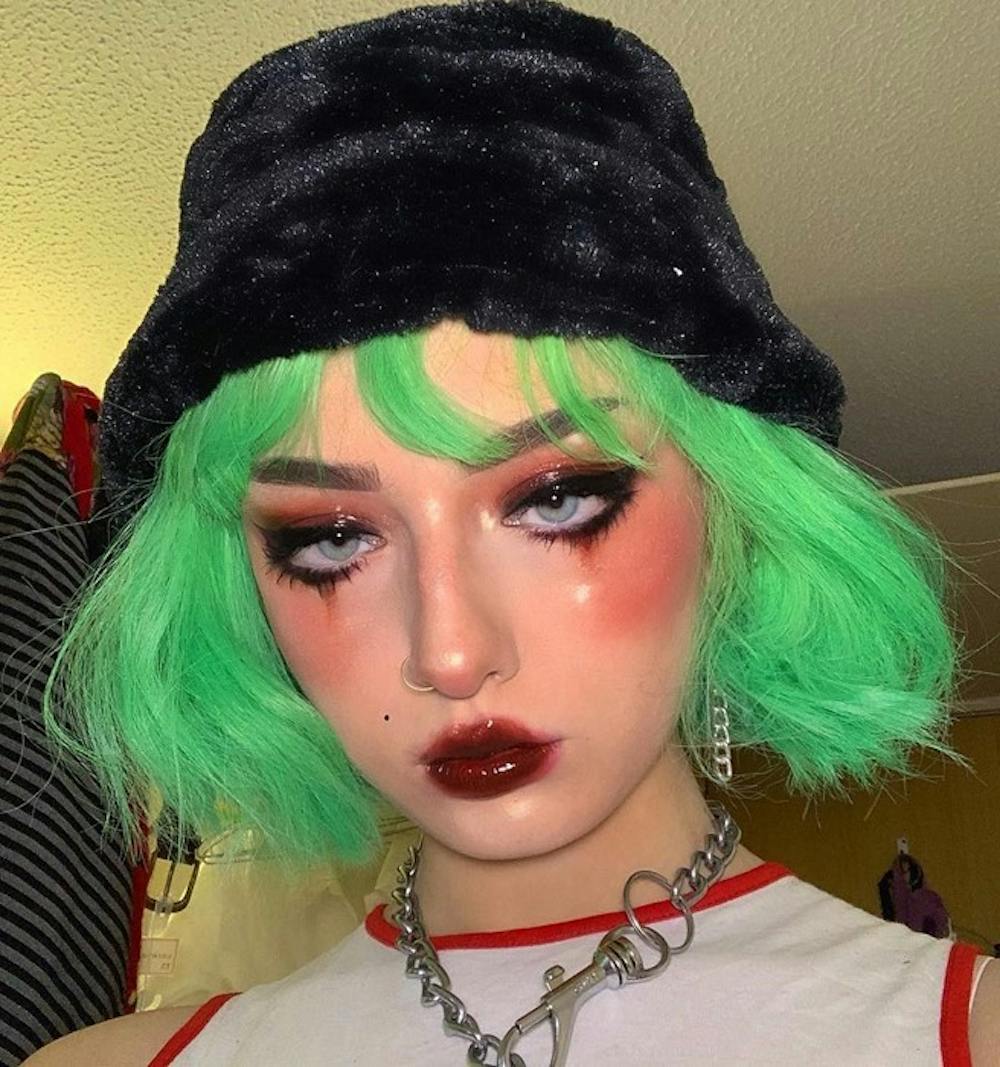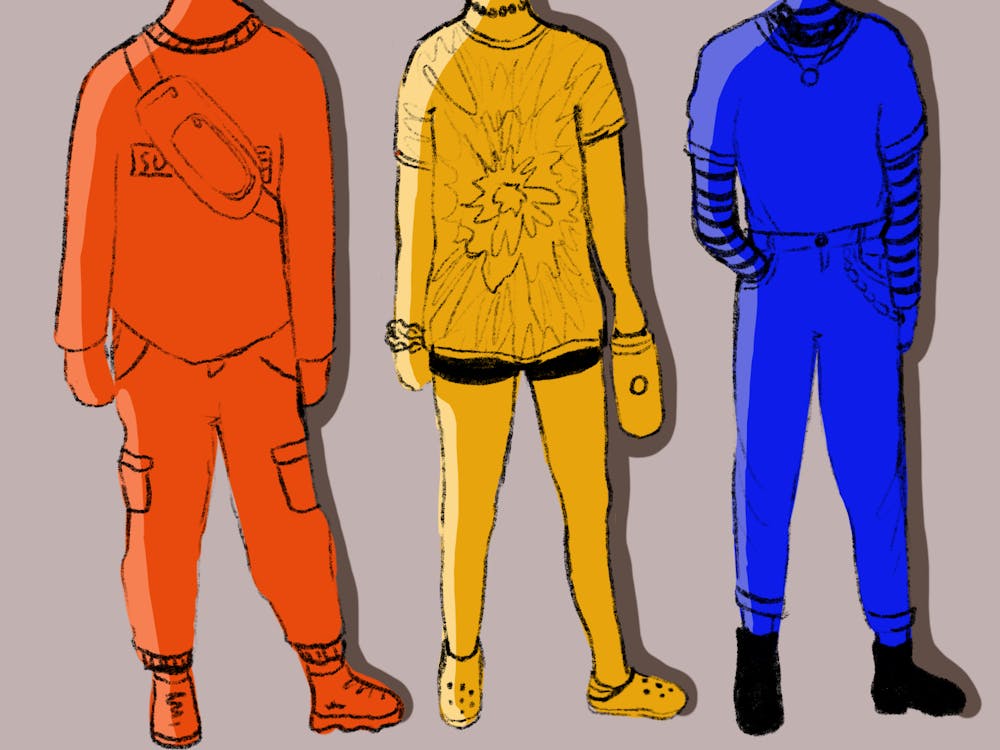Just as banana bread, Chloe Ting workouts, and whipped coffee have become quintessential staples of Quarantine, so have drastic alterations to one’s appearance, especially by ways of their hair. Of these varying hair dye trends, the infamous "e-girl hair" has become ubiquitous— consisting of bleaching or coloring the front two strands of hair.
The accompanying trend amongst their counterpart, e-boys, is a middle part with conspicuously soft hair cascading down each side. However, the label of e-girl or e-boy is actually emblematic of a trend extending far beyond the realm of 15–second videos on TikTok: they are both indicative of a new subculture within fashion, comparable to punk, grunge and hip hop.
According to Attire Club, the term subculture refers to groups with "a particular set of features of appearance, costume and adornment that makes its members distinctive enough to be a clear part of a wider culture." In the context of fashion, subcultures often embody the intersection between social, cultural and political dimensions that envelop the context at the time. This theory was first popularized by Dick Hebidge in his 1979 book, Subculture: The Meaning of Style.
In his exploration of various subcultures, particularly that of the Teddy Boys and mod and punk fashion in London, Hebidge found that their style was a mechanism of embodying "anxieties concerning class and sexuality, the tensions between conformity and deviance, family and school, work and leisure," thus crystallizing socio–cultural tensions into fashion. This style also acted as a voice for the neglected constituency of youth in London, "rendering working classness metaphorically in chains and hollow cheeks, ‘dirty’ clothing (stained jackets, tarty see-through blouses) and rough and ready diction."

Today's online–based youth subcultures, like VSCO girls, soft girls, and Tumblr girls, spawn just as quickly as they seemingly disappear. The e–girl aesthetic, popularized primarily by means of TikTok, is a melange of elements from skate culture, anime, cosplayers, and goth. Staples of this look include colorful hair clips, winged eyeliner, silver necklaces with a lock pendant, and mesh shirts, most of which is either thrifted or bought from popular Instagram retailers. The e–boy look shares many similar elements: high waisted pants, silver chains, and oversized tee shirts. The subculture transcends gender norms, sharing numerous features between the normative female and male styles.

In his original theory, Hebidge contended that style was inextricably linked to musical and political influence. Much of the discourse on this subject shares this post–modern, Marxist framework, contending that subcultures act as a form of classist revolt, as a means to "express and resolve contradictions which remain hidden or unresolved in the parent culture."
Yet, in a society dominated by media that appears and dissipates with the fluidity of waves hitting a shoreline, it becomes increasingly difficult to draw connections between a group’s clothing style, the music they listen to, and their socioeconomic status.
Those who are critical of the modern applications of Hebidge's theory to contemporary subcultures have also postulated that "teenagers are more interested in constructing an identity online than they are in making an outward show of their allegiances and interests." The implication is that the internet affords the ability to commit to a subculture from the recesses of your bedroom, with no real affirmation of any political or social context that may surround it. In combination with the fleeting rate at which these trends gain and lose popularity, then, it is easy to dismiss subcultures such as the e–girl/boy as glib trends that hold no real depth beyond the aesthetic they promote.
However, this feels like an intrinsically reductive argument. While it is true that the age of social media may not spawn the same mass movements bonded by shared interests in music, fashion, and political opinions as seen in the past, the microcosmic ones it spawns still hold significant importance.
Certain elements of the e–girl/boy culture are inherently political—for instance, the rejection of gender norms within the style is indicative of a growing understanding amongst the youth of the fluidity and flexibility of gender constructs and norms.
It is, in fact, reminiscent of the Bowie-ites discussed by Hebidge who confronted chauvinisms of gender and sexuality. With this particular example, Hebidge discussed how Bowie-ites challenged, at a symbolic level, the naturalness of both class and gender stereotypes. These sentiments are echoed in e–girl/boy culture in their rejection of the inevitability or rigidness of gender, with both boys and girls adopting similar styles and clothing pieces.
Another significant aspect is the notion of female empowerment, with some arguing that TikTok’s soft girl aesthetic—often disparaged for capitalizing off a retrograde, "kittenish broadcast of reductive tropes"—acts as a means by which can girls ironize the whole question of power.
The implied girlishness and playfulness of soft girls disguises how much power they have or want, challenging the lens by which we view empowerment. Similarly, the e–girl aesthetic, criticized for promoting a hyper–sexualized anime aesthetic, could serve the same function: challenging why we perceive female empowerment with a specific aesthetic when the purpose of the aforementioned empowerment seems antagonistic to that very assumption.
In general, the digital age encourages the mutability of subcultures, and therefore of identity—there is no requirement to adhere to one specific aesthetic or archetype. A TikTok user, for instance, may adopt a multitude of personas within different subcultures: she may be an e–girl one day, soft girl the next, and VSCO girl the day after. The limited temporality with which these movements gain traction does not necessarily diminish their value nor their association with social or cultural influence. Moreover, criticizing some for not having any value—as was the case with VSCO girls—is actually even more problematic. In this day and age, a subculture should be able to exist for the sake of style itself without invoking backlash.
Therefore, even if e–girls and e–boys do, as some critics contend, exist without any particular association to political and cultural relevance, why does it matter?
The existence of numerous subcultures and the ability of users to move between them is, in itself, a statement on the technological prone society we live in. Moreover, the consideration that we should allow people to enjoy and express themselves, in whatever form that takes, is one of the hallmarks of the acceptance and openness encouraged by many in the modern era. Criticizing or mocking a group is incredibly easy. Attempting to understand the influences and context, is very often the road less taken—and yet, one we should endeavor to take more often.

